-

新人教版高中英语必修2Unit 3 The Internet-Listening &Speaking&Talking教案二
From the pictures in the text and the title--- choose the best app, we can know that this part is about how to save money by using apps.Step 2 While-listening1. Laura and Xiao Bo are talking about apps. Listen to their conversation and find out what apps they want.Xiao Bo is looking for a(n) exercise app to help him get in shape.Laura would like an app for getting rich and another that will make her grades better.2. Listen again. Are the sentences true T or false F?1). Both of Xiao Bo's apps keep track of the steps he takes._____2). Xiao Bo's second app can help him make a fitness plan._____3). Laura needs an app that will help her get discounts.______4). Laura needs an app that will add money to her bank account._______F T F T3. Listen once more and tick the sentence you hear. Underline the words used to express predictions, guesses, and beliefs.Predictions, Guesses, and Beliefs________It might help me walk more.________My guess is that it wouldn't work.________I imagine this app would help me get fit faster________I suppose that would be good.________I guess you could save a little with this app.________I suppose there would be some problems, too.________I believe this app could help me get thinner.

新人教版高中英语必修2Unit 3 The Internet-Reading for Writing教案二
8. However, the more polite you are, the less likely it is you will be attacked. 然而, 你越有礼貌, 你被攻击的可能性就越小。 Step 8 Writing---the articleHow to stay safe in the online chat roomToday I thought I’d blog about a question that has been asked many times--- how do you stay safe online and avoid bad experiences in the online chat room ? I’m not an expert, but many years as a blogger have taught me a thing or two.First of all, there’s the golden rule of the Internet: keep out of what makes you uneasy. Don’t post comments or click on anything. Second, protect your privacy. Don’t give out too much private information like your address, phone numbers, the ID numbers, etc. Third, be polite. If you are polite to others on the Internet, you won’t be attacked in normal situation. Finally, don’t believe in others easily and never meet someone you met online alone. It is very dangerous.Have you had any bad experiences online, or do you have some good advice for staying safe? Post your comments below!Step 9 Pair workExchange drafts with a partner. Use this checklist to help your partner revise his/her draft.1. Does the writer tell the reader what he/she know about the topic ?2. Are the tips and suggestions well organised ?3. Has the writer defined the new words ?4. Does the author include examples, comparison, or explanations ?5. Does the writer end by asking readers to leave comments and/or suggestions ?6. Can you find any grammar or spelling mistakes.Step 6 HomeworkPut up your revised draft in the classroom or read it to your class.

新人教版高中英语必修2Unit 4 History and Traditions-Discovering Useful Structure教案二
This teaching period mainly deals with grammar: The past participle is used as attributive and objective complement.1. Guide students to review the basic usages of the past participle used as attributive and objective complement.2. Lead students to learn to use some special cases concerning the past participle used as attributive and objective complement flexibly.3. Strengthen students’ great interest in grammar learning.1. Help students to appreciate the function of the past participle used as attributive and objective complement.2. Instruct students to write essays using the past participle used as attributive and objective complement.Step1:温故而知新。Analyze the underlined phrases and then sum up the common usages of the past participles.1.(教材P41)They had castles built(build) all around England, and made changes to the legal system.2.(教材P42)They use the same flag, known(know) as the Union Jack,...3.(教材P42)Judy and I had our car parked(park) in an underground car park near Trafalgar Square, where we could get our car battery charged(charge).Common points: f the past participle used as attributive and objective complement.Step 2:过去分词作定语时的意义1.及物动词的过去分词作定语,在语态上表示被动;在时间上,常表示动作已经发生或完成,有时也不表示时间性。Our teacher watched us doing the experiment and gave us a satisfied smile at last.我们的老师看着我们做实验,最后给了我们一个满意的微笑。The plan put forward at the meeting will be carried out soon.会上提出的计划将很快被执行。2.不及物动词的过去分词作定语,它不表示被动意义,只强调动作完成。Many little kids like gathering fallen leaves in the yard.

新人教版高中英语必修2Unit 4 History and Traditions-Reading and Thinking教案二
Step 5 While reading---Task 3Read the text again and answer the following questions.Q1: How many countries does the UK consist of ?4 Q2: What are the four countries of the United Kingdom?England, Wales, Scotland and Northern Ireland Q3: Which two were the first to be joined together ?England and WalesQ4: What are the two chief advantages of studying the history of a country ?The first one is to help you understand more about the country and its traditions.The second one is to make visiting it more enjoyable.Q5: What’s the author’s attitude towards studying the history ?Supportive/positiveStep 6 Post reading---Retell the textThe United Kingdom, Great Britain, Britain, England—many people are confused by (1)_____ these different names mean. In the 16th century, the nearby country of Wales (2) __________(join) to the Kingdom of England. In the 19 th century, the Kingdom of Ireland was added to create the United Kingdom of Great Britain and Ireland. Finally, the southern part of Ireland (3) ______ (break) away from the UK, which resulted in the full name we have today. However, most people just use the (4)_________(shorten) name: the UK. The four countries (5)__________ belong to the United Kingdom work together in some areas. There were four sets of invaders and the last group were the Normans. They had castles (6)_________(build) all around England and made changes (7)__________ the legal system. Studying the history of the country will make your visit much more (8)_________(enjoy). The capital city London is (9)___ ancient port city that has a history (10)______(date) back to Roman times. 1. what 2.was joined 3.broke 4.shortened 5.that 6. built 7.to 8.enjoyable 9.an 10.dating Step 6 Homework

新人教版高中英语必修2Unit 5 Music-Listening and Speaking教案
This lesson is about music. Students can classify the types of music through the instruments and its sound and can talk about their preferences about music, even join some activities and play a role in them according to their musical talents. On the basis, they are guided to use the languages to express their preferences and some plosive sounds and their rules.1. Classify the music types through the instruments and its sound.2. Listen and understand what the speakers’ preferences are and the reasons; talk about their own preferences and give their own reasons, using these sentences: “What kind of music do you like? And why? “ “Because it makes/gives me energy/peaceful.../touches my heart...”.3. Learn some plosives and the rules.4. Join some activities and play a role in them according to the talents. 1. Listen and understand what the speakers’ preferences are and the reasons;2. talk about their own preferences and give their own reasons, using these sentences: “What kind of music do you like? And why? “ “Because it makes/gives me energy/peaceful.../touches my heart...”.3. Learn some plosives and incomplete plosives and its rules.Step 1 Lead inPoint at the pictures on P50 and ask Q1: What are the people doing in the pictures below?Q2: What kind of music they are?Then play the MP3s one by oneStep 2 ListeningTask 1: A reporter from the school newspaper is interviewing students about music. Listen to the interviews. Draw lines between the words to make complete sentences. Some words will not be used.

新人教版高中英语选修3Unit 2 Healthy Lifestyle教案
Activity 4: Figuring out the structure and the writing purpose 本活动为实现课时目标2。 1.Read Paragraph 6 and think about its main idea and the writer’s writing purpose. Q1: If you were the author, how would you end your article? “For young people, there is plenty of time to change bad habits. However, there is no “magic pill” or delete button that will help you; you have to think about your bad habits and decide on some changes. You have the power to build a happy and healthy life full of good habits!” Q2: What is Paragraph 6 mainly about? (Possible answer: to appeal to young people including teenagers to change bad habits and live a happy and healthy life.) 2.Think about the writer’s writing purpose and share opinions. Q1: What is the writing purpose? Work in pairs and figure it out. (Possible answer: On the one hand, the passage is written to help teenagers change their bad habits and live a healthy lifestyle. On the other hand, it provides us with a scientific way to identify and analyse our problems objectively, thus strengthening our resolve to tackle the seemingly common yet tough problems in our lives.) 【设计意图】 步骤1旨在预测和验证文章最后一段主要内容,梳理完整的语篇结构,步骤2旨在思考和讨论作者的写作目的。教师也可根据学生课堂反应情况融入对语篇人称多次转换的思考。

新人教版高中英语选修4Unit 2 Iconic Attractions教案
帮助学生通过讨论与对主题的提升,反思自己的旅游方式,以便做出更优化的安排,在今后的旅程中有更多的收益。 Activity 2: Further discussion of the 6 elements above and supplement of more background knowledge 本活动为实现课时教学目标2。 1.Target Q: The writer’s clear target of traveling, meeting the people and experiencing the culture, is closely related to his major in social studies. Then what is social studies? Social studies is a part of a school or college curriculum concerned with the study of social relationships and the functioning of society and usually made up of courses in history, government, economics, civics, sociology, geography, and anthropology. (Dictionary by Merriam-Webster) Reflection: When you go out to travel, what targets do you usually have in mind? 2.Research Q: Suppose you are traveling to Hangzhou during the school holidays, how will you do research on the city? (surf the internet, read books or travel brochures, consult friends, ...) What information will you be interested to know? (location, iconic sites, local cuisines, interesting customs, shopping malls ...) 3.Abandonment To make the most of time, we have to learn to abandon so that we can accomplish our plan. What will you be interested in doing if you go to Hangzhou if you have a week’s time? What if you only have 2 days? 4~5. Venturing & Experiencing Q: What did he venture to do during the trip? What new experiences did he have? In Sydney: attend his first open-air barbecue, enjoy many different but yummy meals In Catherine: observe the life and customs of the aborigines appreciate their music & try the musical instruments: the didgeridoo
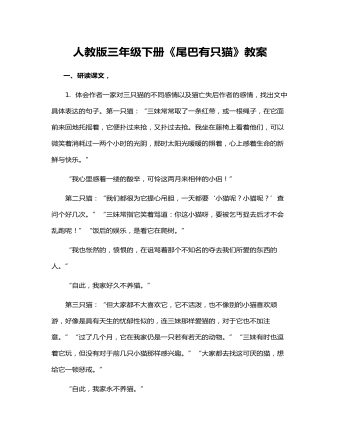
人教版三年级下册《尾巴有只猫》教案
一、研读课文,1. 体会作者一家对三只猫的不同感情以及猫亡失后作者的感情,找出文中具体表达的句子。第一只猫:“三妹常常取了一条红带,或一根绳子,在它面前来回地托摇着,它便扑过来抢,又扑过去抢。我坐在藤椅上看着他们,可以微笑着消耗过一两个小时的光阴,那时太阳光暖暖的照着,心上感着生命的新鲜与快乐。”“我心里感着一缕的酸辛,可怜这两月来相伴的小侣!”第二只猫:“我们都很为它提心吊胆,一天都要‘小猫呢?小猫呢?’查问个好几次。”“三妹常指它笑着骂道:你这小猫呀,要被乞丐捉去后才不会乱跑呢!”“饭后的娱乐,是看它在爬树。”“我也怅然的,愤恨的,在诅骂着那个不知名的夺去我们所爱的东西的人。”“自此,我家好久不养猫。”第三只猫:“但大家都不大喜欢它,它不活泼,也不像别的小猫喜欢顽游,好像是具有天生的忧郁性似的,连三妹那样爱猫的,对于它也不加注意。”“过了几个月,它在我家仍是一只若有若无的动物。”“三妹有时也逗着它玩,但没有对于前几只小猫那样感兴趣。”“大家都去找这可厌的猫,想给它一顿惩戒。”“自此,我家永不养猫。”第一只猫“很活泼”,“我看着三妹逗猫玩的融副泄泄的生活情景,感着生命的新鲜与快乐”,当猫无故病死后“可怜这两月来相伴的小侣”并为之“酸辛”;当第二只“更有趣,更活泼”的猫在周围邻居冷漠的观望中被那些“过路人”捉走后就“怅然”、“愤恨”、“诅骂”,在这段生活经历中展示的“我的人性”充满爱心,表现得十分宽容、温馨、善良和光明。然而在“芙蓉鸟事件”发生后的“我”,不仅只凭主观猜测“妄下断语”,面对猫这个弱小、可怜的动物怒气冲天“拿木棒追打”、“心里还愤的,以为惩戒的还没有快意”,人在动物面前恃强凌弱,则充分暴露了人性中凶恶、冷酷、残暴和阴暗的一面。不过,当“我”明白这只丑猫并非是罪魁祸首后,良心受到了谴责。2. 说说为何“我”对第三只猫的死比前两只猫的亡失“更难过得多”?第二只猫丢失后,作者写道:“自此,我家好久不养猫。”第三只猫死后,作者又写道:“自此,我家永不养猫。”试着联系课文中的描写,体会这两句话中包含的思想感情有什么不同?因为第三只猫的死责任在“我”。我们的主观臆断,断定鸟是它咬死的,暴怒之下“我”用木棒打它,它受到冤苦无处辩诉,最后死在邻家屋檐上。“我”认为是“我”把它害死的,而且这个过失是无法补救的。这句话在内容上是对全文的总结。“我”目睹了前两只猫的不幸后,又亲自制造了第三只猫的悲剧,深感负疚,为了不再看到这样的悲剧重演下去,“自此,我家永不养猫”这句话与文章的开头遥相呼应,在结构上形成了首尾呼应的特点。
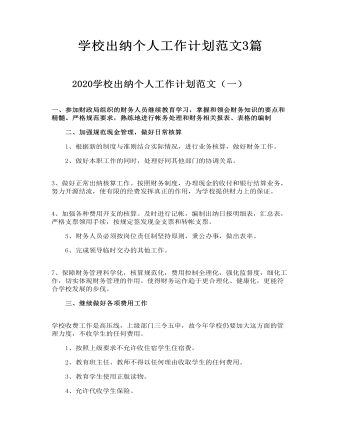
学校出纳个人工作计划范文3篇
1、根据新的制度与准则结合实际情况,进行业务核算,做好财务工作。 2、做好本职工作的同时,处理好同其他部门的协调关系。 3、做好正常出纳核算工作。按照财务制度,办理现金的收付和银行结算业务,努力开源结流,使有限的经费发挥真正的作用,为学校提供财力上的保证。 4、加强各种费用开支的核算。及时进行记帐,编制出纳日报明细表,汇总表,严格支票领用手续,按规定签发现金支票和转帐支票。

第21个全国中小学安全教育日国旗下讲话稿
老师们、同学们:早上好!三月,是春风和煦、万木吐绿、百花盛开、欣欣向荣的美好季节,俗话说:“一年之际在于春。”人们把许多节日或者纪念日都放在了三月,我们走进三月,也就走进了三月的每一个有意义的节日。重要的节日或者纪念日就有下面这几个:3月5日:“向雷锋同志学习”纪念日,3月8日:国际劳动妇女节,3月12日:中国植树节,3月15日:国际消费者权益日,3月21日:世界睡眠日,3月22日:世界水日,3月23日:世界气象日。今天我讲的是大家可能还不太熟悉的一个纪念日:那就是全国中小学安全宣传教育日。这个教育日,是由国家有关部门发出的,确定每年三月最后一个周的星期一作为全国中小学生“安全教育日”。其目的是为推动中小学安全教育工作,降低少年儿童伤亡事故的发生率,保证少年儿童的健康成长。
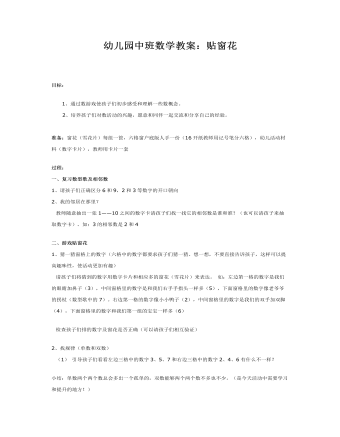
幼儿园中班数学教案:贴窗花
2、培养孩子们对数活动的兴趣,愿意和同伴一起交流和分享自己的经验。 准备:窗花(雪花片)每组一筐,六格窗户底版人手一份(16开纸教师用记号笔分六格),幼儿活动材料(数字卡片),教师用卡片一套过程:一、复习数型歌及相邻数1、请孩子们正确区分6和9,2和3等数字的开口朝向2、我的邻居在那里? 教师随意抽出一张1——10之间的数字卡请孩子们找一找它的相邻数是谁和谁?(也可以请孩子来抽取数字卡)。如:3的相邻数是2和4二、游戏贴窗花1、猜一猜窗格上的数字(六格中的数字都要求孩子们猜一猜、想一想,不要直接告诉孩子,这样可以提高趣味性,使活动更加有趣) 请孩子们将猜到的数字用数字卡片和相应多的窗花(雪花片)来表达。如:左边第一格的数字是我们的眼睛加鼻子(3),中间窗格里的数字是和我们右手手指头一样多(5),下面窗格里的数字像老爷爷的拐杖(数型歌中的7)。右边第一格的数字像小小鸭子(2),中间窗格里的数字是我们的双手加双脚(4),下面窗格里的数字和我们第一组的宝宝一样多(6) 检查孩子们排的数字及窗花是否正确(可以请孩子们相互验证)
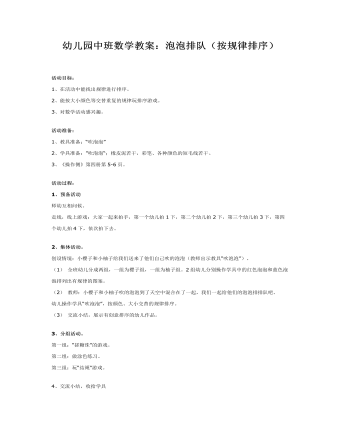
幼儿园中班数学教案:泡泡排队
2、能按大小颜色等交替重复的规律玩排序游戏。 3、对数学活动感兴趣。活动准备: 1、教具准备:“吹泡泡” 2、学具准备:”吹泡泡“;橡皮泥若干,彩笔、各种颜色的短毛线若干。 3、《操作侧》第四册第5-6页。 活动过程: 1、预备活动 师幼互相问候。 走线,线上游戏:大家一起来拍手,第一个幼儿拍1下,第二个幼儿拍2下,第三个幼儿拍3下,第四个幼儿拍4下,依次拍下去。 2、集体活动。 创设情境:小樱子和小柚子给我们送来了他们自己吹的泡泡(教师出示教具“吹泡泡”)。

幼儿园中班数学教案:多变的图形
[幼儿分析] 中班的孩子正是对自己身边的周围事物感兴趣的时期,语言表达不是很完整,也没有什么主见。经过教师的引导和帮助,他们也能将事情做的很好。因此,在活动时,为他们提供一些蕴涵教育目标的,适合他们的材料,让孩子主动参与、积极探索,通过活动,发展孩子的思维,鼓励他们从不同角度思考问题。 [设计思路] 幼儿喜欢探究生活中的数学现象,对长方形、梯形、半圆形、椭圆形产生兴趣和好奇心,为了开展分类、排序等探索活动在生活和游戏中运用已有的经验进行大胆联想和创造;幼儿还需要在各种操作时间中进一步学习、发现,为此设计了本节活动。 [活动目标]1、培养幼儿对拼图添画的兴趣。2、发展幼儿想象力和创造力。3、引导幼儿在认识几何图形的基础上,通过联想画成简单的物体,并表现出其主要特征。
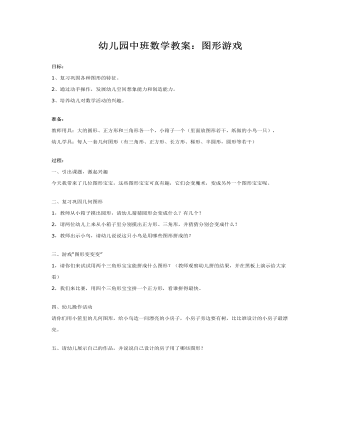
幼儿园中班数学教案:图形游戏
2、通过动手操作,发展幼儿空间想象能力和创造能力。 3、培养幼儿对数学活动的兴趣。准备: 教师用具:大的圆形、正方形和三角形各一个,小箱子一个(里面放图形若干,纸做的小鸟一只), 幼儿学具:每人一套几何图形(有三角形、正方形、长方形、梯形、半圆形,圆形等若干)过程:一、引出课题,激起兴趣 今天我带来了几位图形宝宝,这些图形宝宝可真有趣,它们会变魔术,变成另外一个图形宝宝呢。
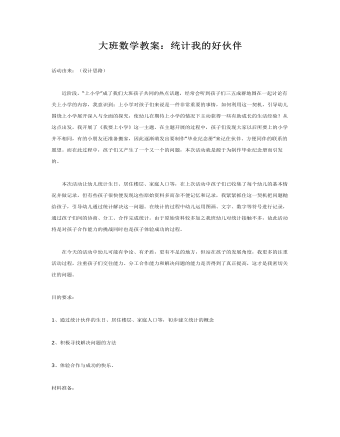
大班数学教案:统计我的好伙伴
本次活动让幼儿统计生日、居住楼层、家庭人口等,在上次活动中孩子们已收集了每个幼儿的基本情况并做记录,但有些孩子很快便发现这些原始资料多而杂不便记忆和记录,我紧紧抓住这一契机把问题抛给孩子,引导幼儿通过统计解决这一问题。在统计的过程中幼儿运用图画、文字、数字等符号进行记录,通过孩子们间的协商、分工、合作完成统计。由于原始资料较多加之我班幼儿对统计接触不多,故此活动将是对孩子合作能力的挑战同时也是孩子体验成功的过程。 在今天的活动中幼儿可能有争论、有矛盾,更有不足的地方,但站在孩子的发展角度,我更多的注重活动过程,注重孩子们交往能力、分工合作能力和解决问题的能力是否得到了真正提高,这才是我密切关注的问题。目的要求:1、通过统计伙伴的生日、居住楼层、家庭人口等,初步建立统计的概念2、积极寻找解决问题的方法 3、体验合作与成功的快乐。
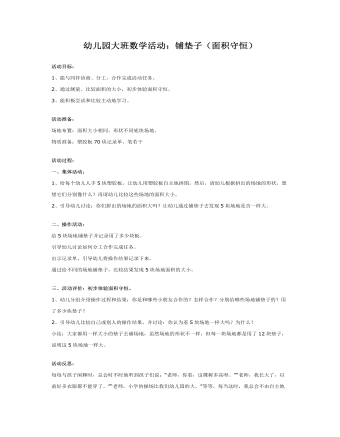
大班数学教案:铺垫子(面积守恒)
2、通过测量、比较面积的大小,初步体验面积守恒。 3、能积极尝试和比较主动地学习。 活动准备: 场地布置:面积大小相同、形状不同底块场地。 物质准备:塑胶板70块记录单、笔若干 活动过程: 一、集体活动: 1、给每个幼儿人手5块塑胶板,让幼儿用塑胶板自主地拼图。然后,请幼儿根据拼出的场地的形状,想想它们分别像什么?再请幼儿比较这些场地的面积大小。 2、引导幼儿讨论:你们拼出的场地的面积大吗?让幼儿通过铺垫子去发现5块场地是否一样大。 二、操作活动:给5块场地铺垫子并记录用了多少块板。 引导幼儿讨论如何分工合作完成任务。 出示记录单,引导幼儿将操作结果记录下来。 通过给不同的场地铺垫子,比较结果发现5块场地面积的大小。
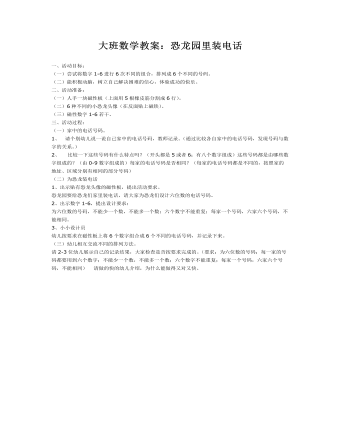
大班数学教案:恐龙园里装电话
(二)能积极动脑,树立自己解决困难的信心,体验成功的快乐。 二、活动准备: (一)人手一块磁性板(上面用5根橡皮筋分割成6行)。 (二)6种不同的小恐龙头像(在反面贴上磁铁)。 (三)磁性数字1-6若干。 三、活动过程: (一)家中的电话号码。 1、请个别幼儿说一说自己家中的电话号码,教师记录。(通过比较各自家中的电话号码,发现号码与数字的关系。) 2、比较一下这些号码有什么特点吗?(开头都是5或者6;有八个数字组成)这些号码都是由哪些数字组成的?(由0-9数字组成的)每家的电话号码是否相同?(每家的电话号码都是不同的,按照家的地址、区域分别有相同的部分号码)

大班数学教案:图形宝宝找家
二、活动准备 画有“〈”“〉”符号卡片两张、1—10数字卡一套、苹果卡片三张、桃子卡片两张、粉笔三支、铅笔一支、练习题每人三张。 三、活动过程 (一) 引出主题,认识大于号 “>” 和小于号 “<”。 1. 教师边出示 “>” 和 “<” 的卡片,边说:“今天老师带来两个好伙伴给你们认识,你们认识他们吗?” 2. 教师出示大于号 “>” (1) 教师:它叫大于号,开口向左,跟着老师念:大于号,开口向着大数笑。 (2) 教师举例,在黑板上写出3 >1,读作三大于一,跟着老师再念一遍,大于号,开口向着大数笑。 3. 教师出示小于号 “<” (1) 教师:它叫小于号,开口向右,跟着老师念:小于号,尾巴对着小数翘。 (2) 教师举例:在黑板上写出2<4,读作二小于四,跟着老师再念一遍,小于号,尾巴对着小数翘。
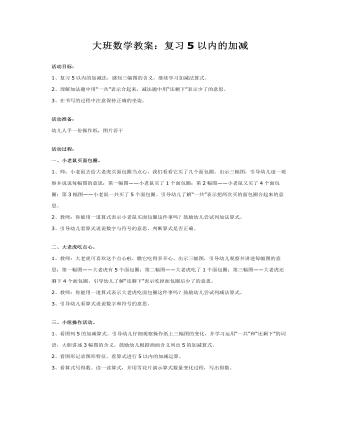
大班数学教案:复习5以内的加减
活动准备: 幼儿人手一份操作纸,图片若干 活动过程: 一、小老鼠买面包圈。 1、师:小老鼠去给大老虎买面包圈当点心,我们看看它买了几个面包圈。出示三幅图,引导幼儿逐一观察并说说每幅图的意思:第一幅图——小老鼠买了1个面包圈;第2幅图——小老鼠又买了4个面包圈;第3幅图——小老鼠一共买了5个面包圈。引导幼儿了解“一共”表示把两次买的面包圈合起来的意思。 2、教师:你能用一道算式表示小老鼠买面包圈这件事吗?鼓励幼儿尝试列加法算式。 3、引导幼儿看算式说说数字与符号的意思,判断算式是否正确。 二、大老虎吃点心。 1、教师:大老虎可喜欢这个点心啦,瞧它吃得多开心。出示三幅图,引导幼儿观察并讲述每幅图的意思:第一幅图——大老虎有5个面包圈;第二幅图——大老虎吃了1个面包圈;第三幅图——大老虎还剩下4个面包圈。引导幼儿了解“还剩下”表示吃掉面包圈后少了的意思。 2、教师:你能用一道算式表示大老虎吃面包圈这件事吗?鼓励幼儿尝试列减法算式。 3、引导幼儿看算式说说数字和符号的意思。
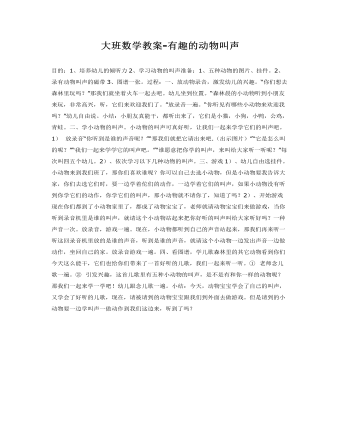
大班数学教案-有趣的动物叫声
1、培养幼儿的倾听力2、学习动物的叫声准备:1、五种动物的图片、挂件。2、录有动物叫声的磁带3、图谱一张。过程:一、放动物录音,激发幼儿的兴趣。“你们想去森林里玩吗?”那我们就坐着火车一起去吧。幼儿坐到位置。“森林晨的小动物听到小朋友来玩,非常高兴,听,它们来欢迎我们了。”放录音一遍。“你听见有哪些小动物来欢迎我吗?”幼儿自由说。小结:小朋友真能干,都听出来了,它们是小猫,小狗,小鸭,公鸡,青蛙。二、学小动物的叫声。小动物的叫声可真好听,让我们一起来学学它们的叫声吧。1) 放录音“你听到是谁的声音呢?”“那我们就把它请出来吧.(出示图片)”“它是怎么叫的呢?”“我们一起来学学它的叫声吧。”“谁愿意把你学的叫声,来叫给大家听一听呢?”每次叫四五个幼儿。2)、依次学习以下几种动物的叫声。三、游戏1)、幼儿自由选挂件。小动物来到我们班了,那你们喜欢谁呢?你可以自己去选小动物,但是小动物要我告诉大家,你们去选它们时,要一边学着佗们的动作,一边学着它们的叫声,如果小动物没有听到你学它们的动作,你学它们的叫声,那小动物就不请你了,知道了吗?

